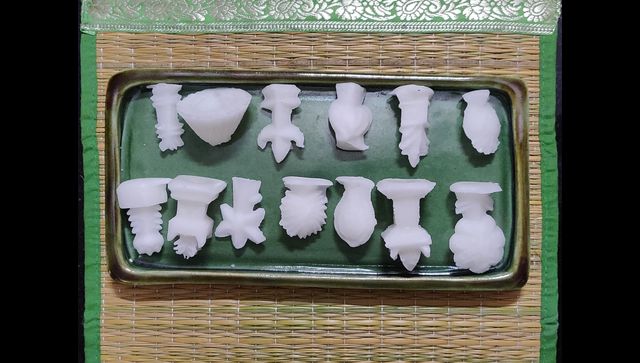Sakkare acchu in Kannada, which translates to sugar moulds, is a sugar candy that is a traditional dish prepared for the Makara Sankranti festival.
Growing up in Hyderabad, the first festival of the calendar year, Sankranti was always special. As a child, the unique tradition of making Ellu Bella (a preparation made with chopped jaggery, peanuts, dry coconut, roasted gram dal, and sesame seeds) was something I looked forward to.
However, what intrigued me was the Sakkare acchu. These small white doll-like pieces made with sugar piqued my imagination especially after hearing my mother regale me with how it was made at her maternal home. “My mother always made the acchu with just sugar and lemon over a traditional stove that used coal. It is a skill that ensured the mould came out perfectly every time,” is how my mother explained the process. Since we lived in Hyderabad, we did not have access to the mould, so it remained a bit of a mystery to me.

After we shifted to Bengaluru in the mid-1990s, I started noticing the local stores selling the sakare acchu during Makar Sankranti. To be honest, I paid little attention to them then as it was ready made and I had no way to find out how they were made. The interesting part was that they came in different shapes and sizes, typically assuming forms like a peacock, a temple, horse heads, fish shapes and lotus floral motifs. However, this year, I decided to finally find out how these cute little sugar dolls are made.
Making some enquiries with old time contacts, I was introduced to 65-year-old Geeta who agreed to show me how they were made. It helped that she had a massive collection of moulds in different shapes that she brought along.
Geeta explained the process, “making the acchu needs patience and comes with experience. Depending on the size of the mould, you can start with one measure of sugar, like a cup and add water to the level that covers it completely and then start melting it over a stove. Once it is done, you need to use a muslin cloth and strain it. Then add some milk and keep stirring it. Once the milk has blended in, strain it again. Repeat the same process with some curds and once you strain it, the impurities present in the sugar will be removed. After that you need to start boiling the syrup again, stirring continually, till it starts thickening. You can squeeze the juice of half a lemon and continue stirring. Finally, you will need to quickly pour this into the mould so that it sets in the pattern chosen.”

The trick to get the acchu right is to ensure that the sugar syrup is cooked well when you can see the water bubbles on the top and then quickly pour it into the mould. If you have done it right, you can see the sugar solidifying even as you pour it inside the moulds. Once done you just need to wait for a couple of minutes and then carefully open the moulds and you have the sakkare acchu in your hands.
The mould itself is quite fascinating and comes in various shapes and sizes. A popular choice is the tiny temple-like structure that has four parts that are secured together with a rubber band. All the moulds have a small opening on the top portion where the hot sugar syrup is poured.

The mould interestingly used to be made of teak wood in the past. As the process is time consuming and needs dexterity, there has been a trend of buying the acchu from stores instead of taking the trouble to make them. However, traditional households believe that making the acchu in this manner is the best way as they stay true to how they are meant to be. “The store-bought ones could have chemicals added to ensure the milky whiteness of the acchu,” warns Geeta.
As moulds themselves are made of wood, it is important to soak them in water overnight or at least six hours before using them so the sugar syrup de-moulds easily without getting stuck. Likewise, as soon as the acchu is demolded, the mould goes back into water so they can be cleaned easily.
A favourite with kids, sugar is also used in another form, small sugar balls strung into a chain that kids under five years old are made to wear on Sankranti. There is an arati performed and it is believed this will ward off the evil eye and ensure the children are healthy and happy through the year. A wish that is as sweet as the memories of the festival itself. And one we can all use now.
Views expressed are personal
Read all the Latest News, Trending News, Cricket News, Bollywood News,
India News and Entertainment News here. Follow us on Facebook, Twitter and Instagram.







More News
Lok Sabha Elections 2024: Congress Puri Candidate Sucharita Mohanty Returns Ticket As Party Denied Funding
Shouldn’t have happened: Mahajan on Congress candidate’s pullout in Indore | India News – Times of India
CAA Showcases Indias Welcoming Nature…..: EAM Jaishankar Counters US Prez Bidens Xenophobic Charge